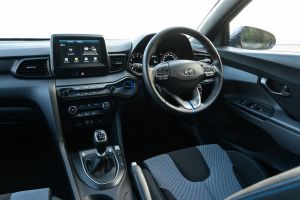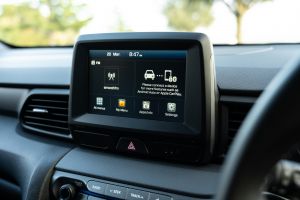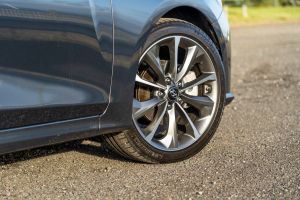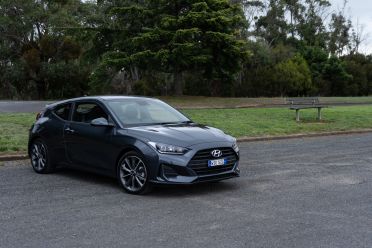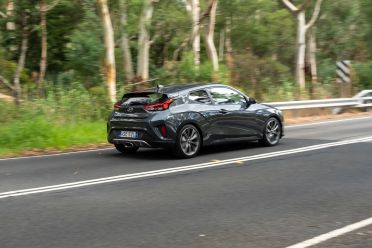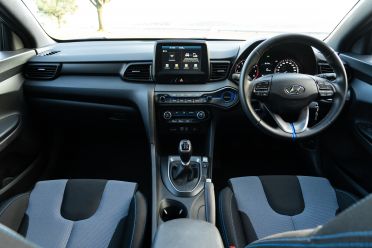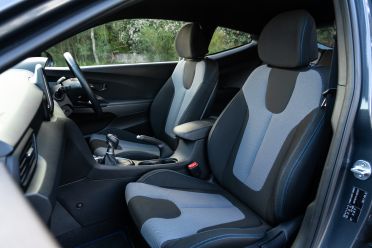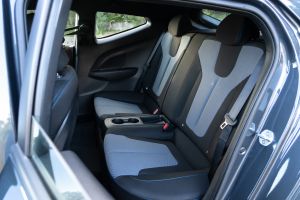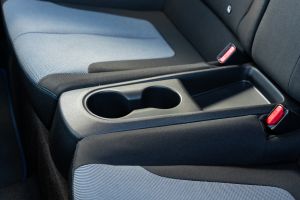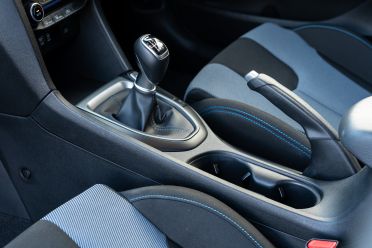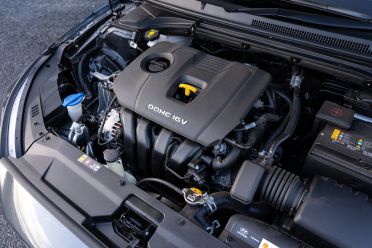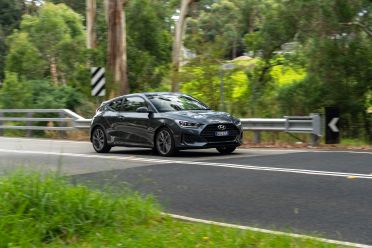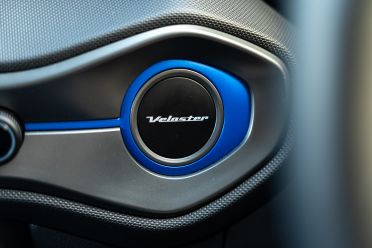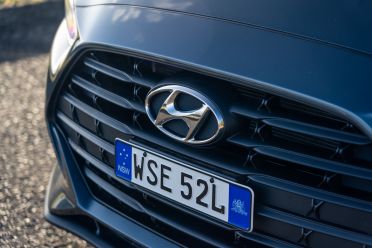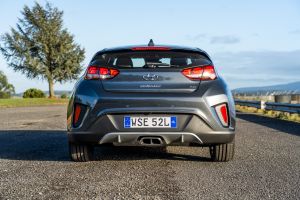Introduction
We live in a time of strange body styles. Forget conventional sedans and hatchbacks, it’s all about four-door coupes and crossovers with sloping roofs.
But even among the crowd of niche-busting specials, the 2020 Hyundai Veloster stands out.
With two doors on the passenger side and just one on the driver side, it’s the only car of its kind on the market in Australia.
The first-generation car introduced the Hyundai brand to a younger audience, now the second-generation model is here to carry the torch.
All its uniqueness comes at a cost, though. Can the Veloster justify a hefty price increase over the more practical i30 with which it shares its bones?
How much does the 2020 Hyundai Veloster cost?
Pricing for the 2020 Hyundai Veloster kicks off at $29,490 before on-road costs for the six-speed manual model you see here.
If you don’t want a manual, the base Veloster is offered with a six-speed automatic for an extra $2300. The more powerful Veloster Turbo is priced from $35,490 before on-roads.
What do you get?
Although it’s a base model, the Veloster is well equipped. It gets six airbags, lane-keeping assist, camera-based autonomous emergency braking, a reversing camera, and rear parking sensors.
The driver and passenger sit in well-bolstered sports seats, and the steering wheel and gear knob are trimmed in leather.
Sitting atop the dashboard is a 7.0-inch touchscreen with Apple CarPlay and Android Auto, but no inbuilt satellite navigation.
It feels small compared to the 8.0-inch system offered on the up-spec Turbo, let alone the 10.0-inch display rolling out in the latest Kia and Hyundai product.
Elsewhere there’s climate control and a 3.5-inch driver display. Externally the car rides on 18-inch alloy wheels wrapped in Michelin Pilot Sport 3 tyres, features LED daytime running lights, and heated side mirrors.
Regular cruise control is standard, rather than the adaptive system offered elsewhere in the range.
Hyundai won’t sell you another door for the driver side no matter how much you offer to pay.
Is the 2020 Hyundai Veloster safe?
ANCAP hasn’t tested the 2020 Hyundai Veloster. Although the related i30 hatchback was rated five stars in 2016, the rules have since changed.
The base Veloster would likely score four stars in ANCAP testing because its camera-only autonomous emergency braking system doesn’t feature pedestrian or cyclist detection.
Hyundai does offer a more sophisticated radar and camera-based system on the more expensive Veloster Turbo, which would likely earn it a five-star rating.
What is the 2020 Hyundai Veloster like on the inside?
Think of the Veloster like an i30 with the sportiness cranked up and the practicality turned down. The driver and passenger sit lower in the Veloster, gripped more tightly in the sports seats, while the rising windowline adds to the sense of theatre.
The driving position is excellent, with plenty of adjustment in the seats and wheel to house taller drivers, and all the major controls fall easily to hand. Hyundai does ergonomics well.
There are only two rear seatbelts, and the central pew has been replaced with a plastic cupholder segment.
Rear legroom is limited with a taller driver up front, and headroom has suffered because of the Veloster’s sloping roofline. The pinched windowline makes things dark back there, too.
With that said, things are pretty friendly in the back of the Veloster compared to the torture chamber that is the Subaru BRZ. The rear door also gives it a huge practicality boost, as anyone who’s tried to convince their friends to hop in the back of a two-door car will attest.
Boot space is a handy 303L with the rear seats in place, but the size and shape of what you can carry is limited by the size of the Veloster’s hatch. I’m sure you could squeeze a set of golf clubs in there if you’re determined, but I gave up and put mine on the back seats.
The rear seats fold flat, revealing 1081L of space.
So far, so sporty then. But in the base Veloster there just isn’t enough design spice to match the interesting exterior.
There are a few splashes of blue trim on the dashboard, the seats have a cool chequered flag pattern on them, and the centre console has a more sculptural design than that of the i30, but that’s about it.
It’s just too dark and plasticky for our liking, especially considering the $30,000 starting price. The centre console is black, as are the door trims. There’s a texture to the dashboard but it’s also black, and the design just isn’t all that sexy.
What’s under the bonnet?
Power in the Veloster comes from a 2.0-litre four-cylinder petrol engine making 110kW and 180Nm, down 10kW and 23Nm on the 2.0-litre offered in the regular i30 hatchback, and 40kW and 85Nm down on the range-topping Veloster.
It’s sent to the front wheels through a six-speed manual transmission, although a six-speed automatic is optional.
Hyundai claims a fuel economy figure of 7.0L/100km, and we saw 7.6L/100km over a week skewed slightly towards highway driving.
The base Veloster needs 91RON regular unleaded fuel.
How does the 2020 Hyundai Veloster drive?
Think of the Veloster as a slightly more hyperactive i30. The steering is faster, it sits slightly lower, and the gearing is shorter to deliver a sportier drive.
Don’t be fooled though, the base Veloster isn’t a sports car.
For starters, the engine doesn’t inspire the driver to push. It’s smooth, quiet, and provides adequate performance, but there isn’t much joy to be found in pushing to the upper reaches of the rev range, especially if you’re hoping for a rorty exhaust note.
In more positive news, the manual transmission is mostly excellent. It’s buttery smooth, sliding effortlessly through tightly-packed gates.
The trade off for the short gearing is a car spinning at 2600rpm when you’re doing 100km/h, undermining its credentials as a relaxed highway cruiser.
The clutch is light, but it can be a bit tricky to take off smoothly thanks to a snappy throttle tune at low speeds. Familiarity makes things easier, but the learning curve is steeper than it really should be.
The pedals are well placed for rev matching, too.
Despite its 18-inch alloy wheels and lowered ride, the Veloster is comfortable around the city. It handles like a slightly sportier i30 on the open road, with a slightly sharper front end.
You can be confident throwing it around, with plenty of grip on offer from the Michelin Pilot Sport 3, but it doesn’t feel particularly lively or adjustable.
How much does the Hyundai Veloster cost to run?
Servicing for the Hyundai Veloster takes place every 12 months or 15,000km – whichever comes first.
The first five years of maintenance will cost $1661 under Hyundai’s capped-price service plan.
CarExpert’s take on the Hyundai Veloster manual
I struggle to understand the base Veloster. It looks sharp, and the success of the original shows there’s a market for cars look and feel different for the sake of it.
The fact it’s more practical than the average sports coupe is handy, and no doubt broadens its appeal.
But the engine isn’t powerful or interesting enough to justify the car’s sporty billing, and the $30,000 price is hard to swallow when the more powerful i30 N-Line manual is almost $4000 cheaper, more practical, and just as good to drive.
I’d save the money and go for the i30. The base Veloster just isn’t special enough.





